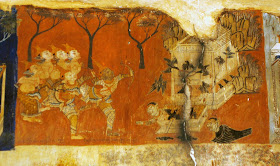South wall,
upper register
This register must be read from
left to right.
 |
Fig.1.On
the left part of the picture, Ravana is depicted in his palace of Lanka giving
the order to Ka Kanasun to transform into a crow and, together with others, to
attack the ascetics in meditation. On the right half of this panel is another
building, on blue background, in which Rama and Lakshmana are sitting close to
Dasaratha (and a consort) listening to a request of an ascetic to kill Ka
Kanasun.
|
 |
Fig.2.S.
- Rama and Lakshmana are seen later in the forest (painted with a red
background) killing a storm of crows flying around a hermitage with their
arrows; one crow has the head of a yaksha, probably being Ka Kanasun
(lower right).
|
 |
| Fig.3.S. – In their royal palace King Dasaratha (Tosarot) and his wife give
permission to Rama and Lakshmana to leave (Rama has dark skin and stays in the right
pavilion); the two are then shown walking away into the forest. |
 |
Fig.4.S.
- Lakshmana (left) and Rama, after walking in the forest, reach a small
pavilion where they can rest, where the two princes extends their arms over a
small brazier to warm their hands.
|
 |
Fig.5.S.
- On a blue-black background, Rama is depicted taking part in the contest to
obtain Sita’s hand in marriage (left). The ritual (svayamvara) was initiated by Janaka, king of
Mithila.
|
 |
Fig.5b.S.;
on this panel Rama is illustrated very low
key, after lifting from the ground the
heavy ancestral bow of Shiva (lower left),rising it and shooting an arrow into
the sky (center left). Janaka is depicted as an ascetic at the door of his
hermitage (middle-center).
|
 |
Fig.5b.S
- Detail. Outside the hermitage Rama’s holds gently the hand of Sita, in the
presence of a hunchback servant.
NOTE -The visual narrative of Wat
Bo does not depict the marriage of Rama and Sita and the dethronement of Rama,
but jumps directly to Rama’s banishment from Ayuthaya to wander in the forest
for fourteen years.
|
 |
Add captionFig.6.S.
The event painted with light-blue background refers of Bharata and Sutragughna
with their army begging Rama to return and take the throne.
|
 |
Fig.7.S.
- In the forest, Rama, Sita and Laksmana came to a river that they have to
cross; the painting shows Laksmana pulling a thin raft across the waters with
Rama and Sita on board.
|
 |
Fig.8.S.
- The degraded mural that follows illustrates the continuation of the wandering
in the forest of Rama, Sita, and Lakshmana and their encounter with Surpanakha,
transformed into a radiant girl of divine beauty, although her mouth still has the fangs of a demon. Because of her
amorous insolence, Laksmana cut off her hands and feet, as well as her ears and nose; crying and bleeding she
returned to her brother Ravana, reporting the accident and describe the beauty
of Sita. Ravana became infatuated with Sita based on the description of
Surpanakha and started to think of a way to steal her for him.
|
 |
Ravana
is shown as the usual ogre but with two arms only, grabbing Sita with them, abduct
her and flying away into the sky, but not on a chariot as in the texts. (Right,
detail).
NOTE. In this scene Ravana is
shown, not disguised as the brahmin narrated in texts.
|
 |
| Ravana flaying away after kidnapping Sita, is attacked by the giant bird
Jatayu. |
 |
All this
could happen because Rama had been distracted a dragged in deep forest by the
demon Maricha, who, to please Ravan,a transformed into a golden gazelle.
Rama
and Lakshmana were unaware the Sita had been kidnapped and are distressed
emotionally and physically.
|
 |
depictst
Drama and Lakshmana fooled and lost in the jungle but the giant bird Jatayu gives
them some information.
|
 |
- After
this episode, the visual narrative moves to the scene of the first encounter of
the two princes with Hanuman. The following panel depicts Hanuman on a tree
dropping leaves on the sleeping Rama to get his attention; Lakshmana was upset
and aimed an arrow at Hanuman, but Rama stopped him. In the poorly preserved
panel that follows, Lakshmana and Rama listen to Hanuman, all seated under a
tree. Having introduced Sugrib it was inevitable to illustrate the fight of his
brother Sugriva with the buffalo Valin in the picture that follows.
|
 |
The visual
narrative then switches to the legend of Valin fighting the buffalo Thoraphi. The mural is deteriorated
and the monkey king Valin (oddly painted red instead of green) is hardly
discernable fighting the buffalo inside a narrow building, probably representing
a cave in the intention of the painters.
The
right half of the picture deals with episode after Valin killed Thoraphi, he
thought that Sugriva had tried to usurp the throne by blocking him in the cave
where he fought the bull; thus, Sugriva was banished from the kingdom, met Rama
and formed an alliance.
The mural depicts these three scenes, Hanuman
entertaining Sugriva, Rama and Lakshmana kneeling in front of Sugriva asking an
alliance. On top is Lakshmana comforting Sugriva.
|
The
end of the upper register of the south wall.
The
continuation is on the middle register of the same wall.
















No comments:
Post a Comment